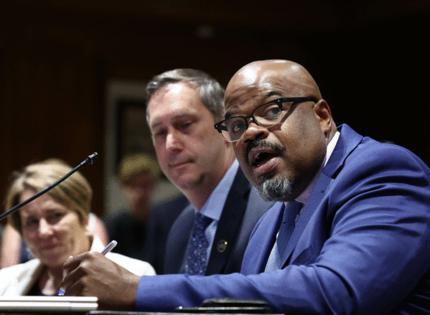Massachusetts education board bars locked, forced 'time-out rooms' in schools
Published in News & Features
BOSTON — The state Board of Elementary and Secondary Education voted unanimously Tuesday to narrow the use of “time-out” rooms in schools, taking steps to ensure the spaces are safe and unlocked and seclusion is only used in emergency situations.
“Inclusive, accessible, safe and welcoming school environments are critical for students to learn and grow academically, behaviorally and social-emotionally,” Education Secretary Patrick Tutwiler said Tuesday.
“And we know that an important part of that is seeing all students learn alongside their peers to the greatest extent possible. The changes approved today give schools and districts additional clarity on appropriate behavioral supports that should be in place for all students to thrive.”
The regulation, which underwent a public comment period in March, updates the definition of time-out and use of seclusion — aiming to keep students safe from a practice advocates say can be traumatic for vulnerable students.
Tutwiler recommended pushing the implementation of the changes from September 2025 to August 2026, allowing more time for schools to undergo trainings and adapt practices.
The changes define time-out to be “in an unlocked setting from which the student is permitted to leave” and more closely align the definition of seclusion with that used by the U.S. Education Department’s Office for Civil Rights.
A room or area used for time-out must be an appropriate size for the student, appropriately lighted, ventilated, heated or cooled, and free of dangerous objects or fixtures, the regulations state.
The regulations also updated after the public comment period to allow for the emergency use of seclusion “as a last resort if there is an imminent threat of assault or serious physical harm to the student or others.”
In the emergency situations, an adult must be present to monitor the seclusion, the school must have prior consent from the student’s family and a licensed mental health professional and physician. After the situation, parents must be notified and schools must conduct weekly and monthly reviews of seclusion incidents.
“Our students deserve safe and healthy learning environments, free from harmful seclusion practices that are detrimental to their wellbeing,” said Attorney General Andrea Joy Campbell.
DESE initially issued guidance on the practices in 2021. In 2023-24, the department stated they issued $1.5 million in grant funding for schools to update policies. With the new regulations, DESE officials said they will issue a minimum of $3 million in funding for updates.
Public commentors spoke on both sides of the issue Tuesday, with some arguing the loss of the tool will hamper educators ability to keep kids safe and others rebutting that the proposal does not go far enough to end the “dangerous practice.”
“For those of us in the field who are doing our very best to provide high quality educational services to students who, because of their disabilities, are often highly dysregulated, which often manifests in physically aggressive behavior either through self injurious behavior or aggression toward others,” said Catherine Cooper, executive director of the Southeastern MA Educational Collaborative, “the inability to separate a child from others will create an environment that is unsafe and where students cannot learn.”
The changes follow testimony by a number of parents who explained the traumatic effect of seclusion on their children.
“Research shows that timeout rooms and seclusion increase stress behaviors, creating a cycle of trauma, harm and repeated seclusions and timeouts,” said Massachusetts parent Emily Lamarca, noting her child’s experience. “It is possible to break this cycle, if the department prioritizes this issue and actively seeks to implement proven alternatives in our schools.”
Despite the unanimous vote, member Michael Moriarty said he approved the changes with “trepidation.” Moriarty questioned whether the department is doing enough in terms of ensuring compliance rather than simply regulating, noting “sometimes the language is too weak.”
“I think within the department there should be a deep look at the capacity for intervention and correction,” Moriarty said. … “We are not where we need to be in terms of addressing problematic districts that seem to not see a problem. And that is a compliance issue, not a regulatory issue.”
________
©2025 MediaNews Group, Inc. Visit at bostonherald.com. Distributed by Tribune Content Agency, LLC.







Comments